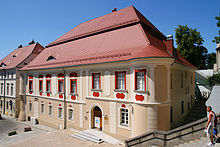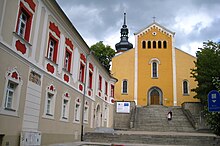Museum of Opole Silesia
The Museum of Opole Silesia ( Polish Muzeum Śląska Opolskiego ) is a regional museum of the Opole region in the capital of the province, in Opole ( Opole ), Poland . It is located directly below the Bergelkirche on the "Mons Universitatis" and was extensively expanded and restored by the end of 2008 with the help of EU funds. It is a museum registered with the Polish Ministry of Culture and is managed by Urszula Zajaczkowska.
prehistory
The main building is located in the old Jesuit College, which was created at the end of the 17th century from the harmonious connection of two town houses (16th century) and redesigned in baroque style in the second half of the 18th century. After the dissolution of the Jesuit order in 1773 it was taken over by the Prussian administration; it served at times as a residential building, government building and hospital. In 1932 the City Museum moved in, which in 1950 was expanded to become the "Muzeum Slaska Opolskiego" ( Museum of Opole Silesia ). Even before 1989 there was an exhibition on the history of the region here. At that time, the German part of history was still largely "hidden".
Museum parts after the expansion
Connected to the Jesuit college by a small glass bridge, a second building is immediately below, which houses the museum administration and workrooms. The main exhibition area is located in the new building "Nowy Gmach" (New Building) behind the Jesuit building and is connected to it. The new main entrance to the museum is located there at ul. Muzealna ( Museum Alley ). There is a roof terrace above the exhibition floors of the new building, which allows a view of the old town of Opole. The fourth building of the museum is the "Kamienica Czynszowa", a tenement house from the 19th century at ul. Wojciecha 9, in which a museum about the urban living and everyday history of Opole has been created. It is briefly called the "town house". There is also a gallery for Polish artists.
Permanent and temporary exhibitions
The museum has permanent exhibitions in a historical, an ethnographic and an archaeological section. After the modernization of these exhibitions, further temporary exhibitions are planned, which will deal with the cultural diversity of the Silesian country. There are also plans to design the labeling of the exhibits in two languages first and in four languages in the long term in order to increase the attractiveness of the museum for foreign visitors.
Web links
- Museum website (multilingual)
Footnotes
- ↑ Gerhard Schiller. Old and new harmoniously united. Reopening of the "Museum of Opole Silesia" in themonths. "Schlesien Heute" No. 124, p. 18ff.
- ^ Beata Kubica et al. Gerhard Schiller. Searching for traces in Opole. In conversation: Urszula Zajaczkowska, director of the "Museum of Opole Silesia" . "Silesia Today" No. 127. P. 24ff.
Coordinates: 50 ° 40 ′ 8.2 ″ N , 17 ° 55 ′ 29 ″ E


